SEO For Nonprofits: Acquire Major Exposure & Donors

You own or work for a nonprofit—we love it! What’s your nonprofit’s mission?
Whether it’s planting trees, feeding the hungry, or another unbelievable cause, the general objective is to help people and make the world a better place.
But… how can you help people if people don’t know about your organization? Problematic, right?
This is why SEO for nonprofits has to be a top priority.
Why Nonprofits Need SEO
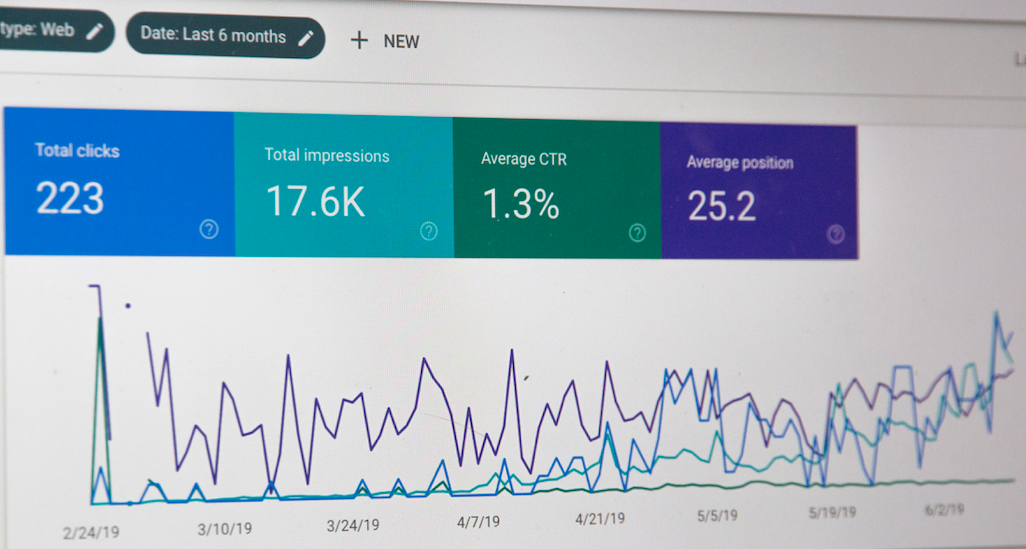
Search engine optimization, or SEO, is a marketing technique that drives major traffic to your nonprofit’s website.
This results in more and more:
- Awareness
- Donations
- Recruiting efforts
- Local or global expansion
The way search optimization is done is by targeting specific keywords that you include in your content. This gets your website to show up on the front page of Google and other search engines.
You maybe wondering if experimenting with SEO is even worth it. Stats say it’s a no-brainer: 93% of online experiences start with a search engine.
More convincing, once results come up on a page, 60% of clicks go to the top 3 websites. This means that if your page doesn’t at least come up on the first page, it’s likely no one will ever see it.
As a nonprofit, you are doing your part to raise awareness for a cause and make a difference. It is especially important that you integrate SEO as a regular part of your marketing strategy to help your organization help more people and improve the world one day at a time.
And get this: There are more than 15 million nonprofits registered in the US.
A lot of donors and sponsors are turning to search engines to find nonprofits to donate their money to. You’re going to want your website to be the first they see so they donate to you.
Fortunately, SEO is going to help you improve the visibility of your website to break through the noise to have a difference-making nonprofit.
Executing SEO For Nonprofits
1. Optimize Your Company Name
Let’s have a little chat about keywords.
SEO uses keywords to get organic traffic to this site. Keywords are phrases that the user will enter in a search engine to find websites that relate to that phrase.
You will be placing that keyword across your website so Google knows to show the user your page when they type those words in the search bar.
You first thought might be to use “nonprofit” or “charity” as a keyword. Makes sense, since that’s what your organization is.
Now, remember back to those 15 million nonprofits that are registered in the US? They’re also trying to use “nonprofit” or “charity” for SEO. Broad words like these are nearly impossible to secure a first page spot with.
Luckily for you, you have a company name that uniquely defines you.
Optimizing your company name for gaining first page rankings is a must do. There is much less competition for a specific keyword, like a company name, than a broad keyword, like “nonprofit”.
2. Utilize Your Local SEO
Don’t sleep on local search optimization. It’s extremely effective.
Many donors and sponsors look for nonprofits that are local to them. Investing in your own backyard is almost always more appealing than ten thousand miles overseas.
As we already discussed, sponsors and donors are looking to search engines to discover nonprofits to donate money to.
To rank for these searches, we would encourage you to include your city or town on multiple website pages. This way, when people search for nonprofits in your town, you’re more likely to appear.
There are other local keywords that may benefit you as well. A clean water company would be wise to make an ultimate guide of natural water lakes in the area and then subtly pitch their mission in the conclusion.
When you’re creating content and deciding what to use, do some keyword research to find some easy to rank on the first page and used in your area. Then create content around said words.
Create A Google My Business
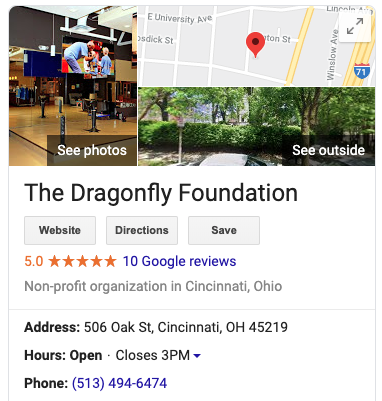
Google My Business and local SEO go hand in hand.
Google rewards companies that use and promote their tools with boosted rankings.
Lucky for you, we have a guide for setting up a Google My Business to your advantage.
It is fairly easy:
- Go to Google My Business.
- Enter in the name of your nonprofit as well as the address. (If the nonprofit is run from home you don’t need to put in the address if you don’t feel comfortable advertising your home address on the internet.)
- Next, write the additional information they ask. This is simple information like the hours you operate, how to reach you and any pictures you have that represent your nonprofit.
- Finally, you’ll verify your business.
It’s pretty easy to do and earns you some brownie points with Google. If you don’t choose to set this up, you’re missing out on a pretty great opportunity to maximize your SEO.
Use Google Maps
This is another Google tool that you should utilize to earn some bonus points for higher rankings.
When you create a bio on any social media, you’re likely going to include an address for people. When you add an address, you should embed a Google Map with it. This will take a user directly to Google Maps when they are going to your nonprofit.
It may seem like an unnecessary step when you’re updating your various platforms to utilize SEO. But it will end up paying off in the end when you get a higher ranking.
Ask For Reviews
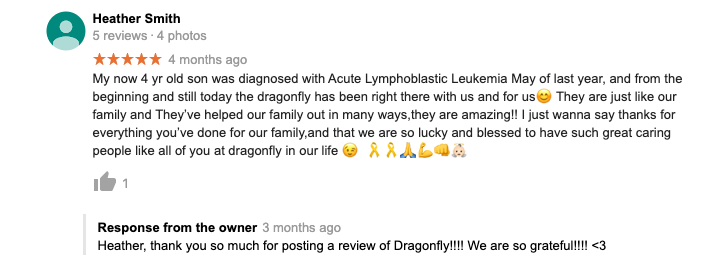
Reviews are home runs in online marketing!
Why? 84% of consumers trust online reviews as much as recommendations from friends and family.
Online reviews can convince a donor to donate big money or a stream of volunteers to continue to help out.
Reviews play a factor in SEO as well. Positive Google reviews are known to increase your local Google rankings.
The question is, how do you get people to leave reviews?
The easiest way is to simply ask. In your normal conversations, ask anyone that interacts with your nonprofit (volunteers, people you’ve helped, or even other sponsors) to leave a review on Google.
It’s often a simple conversation: 70% of consumers say they will leave a review if they’re asked politely.
If you still aren’t getting reviews, then you can send a sweet email to previous people who were engaged with your nonprofit, sending a link to the review page.
This goes without saying, but if someone had a bad experience with your nonprofit then it’s unwise to ask them for a review, for any reason.
Finally, reviews are a great place for you to interact with people that contribute to your nonprofit.
Anytime someone leaves a review, positive or negative, you need to respond politely.
Responding lets people know that you care and value what they have to say—even if you disagree. That’s true professionalism.
3. Content Is King
There’s no escaping this one: SEO is heavily dependent on content.
The content that ranks on Google is not an Instagram post, but a highly detailed blog post.
This writing needs to be full of value, help your audience, and published consistently to start driving website traffic
We have two world-class guides that show you how to set up a blog for SEO and how to write content for more information.
For now, we’ll focus on the basics.
Quality Over Quantity Of Content
You may be tempted to sacrifice quality to get a lot of posts published to increase SEO.
We strongly advise against this!
Here’s why. The main thing that gets people to return to your site is the quality of your content.
Is it relevant, original and helpful? If the answer to any of those questions is no, then you need to do some serious revisions.
And you should never post a blog unless you think it is superior quality.
After all, having bad content will reflect poorly on your nonprofit. If you don’t care enough about the quality of your posts, then what does that say about the quality of your organization?
This is especially important for nonprofits because what you’re writing about will likely be real issues that affect people daily. If you don’t focus on the quality of it, then it can appear to the reader that you don’t really care about the issues your nonprofit represents.
And who wants to partner with an unsympathetic organization?
Quality needs to be your number one priority when you create and publish any kind of content, but especially blog posts.
Utilize Long Tail Keywords
Knowing what keywords your audience is searching allows you to know what content to write and how to write that content. It’s the key to open a locked door.
I would advise you to spend some time researching keywords and figuring out what gets searched most often.
When you do your research, you may be tempted to choose short keywords that have a lot of searches per month. These are actually the most competitive keywords, and ones to stay away from when starting.
What will actually give you results are long tail keywords.
Long tail keywords are keywords that consist of 4 or more words. These will have higher odds of your content showing up on Google while also allowing you to still target your content to specific people.
The beauty of long tail keywords are that you have short term keywords living within them. For example, the keyword phrase “local food pantry in Dallas” also has the keyword “food pantry” embedded in it.
Because of this, the short keywords you initially wanted to rank for will still get boosted when you focus on long tail keywords.
Factually, long tail keywords are also often 10-100 times less competitive than one or two word keywords.
Create Extensive Content
Creating extensive content goes hand and hand with writing a killer, in-depth post.
You should always aim to go in-depth with your content.
A great way to know how in-depth to go is to see how deep your competitors go. Say they write a post that has 1,500 words and a few infographics. Then you should create posts that are 2,500 words, with more research, and more questions answered.
Going above and beyond allows you to:
- Raise more awareness for the subject of your nonprofit
- Explain what makes your nonprofit different
- Include personal testimonies and stories of people that relate to your cause
Do this and you’ll happily discover that Google ranks search results by best content to worst.
Say Google’s ranking two pages. Ine has 500 words and another has 1,500 words, odds are the second one will give a better answer—and rank higher— because they have more words to work with to prove their points.
4. Improve User Experience
The next aspect of your nonprofit we’re going to focus on is your website.
Your website plays a large role in SEO. A storm of website traffic with a slow, confusing, messy site won’t produce any results.
Why make that mistake when a professional, simple website design is all you really need?
Know your website is usually the first impression people will get of your nonprofit. The way your website looks, runs and is set up can determine how people view you.
If it takes forever to load, looks unprofessional and is difficult to navigate, then the person visiting your page is going to leave… never to return.
Your website should reflect who you are as a nonprofit. It should include elements that are relevant to the cause you support.
For example, if your nonprofit is focused on raising awareness for breast cancer, then you should include pink elements on your website.
The goal is to keep it simple. People don’t care as much about the flashy extras as they do about how easy it is to find information about who you serve, who you are, and why.
Increase Website Speed
After web design, the next place you should focus is your page loading speed.
How fast your page takes to load is a factor that affects how Google ranks your site.
People are affected too: 57% of users said they will leave a page if it takes more than 3 seconds to load. (That’s a SEO industry term for a high bounce rate.)
Really think about that. It only takes 3 seconds to completely blow your chance with a potential donor.
Busy websites typically put a heavier burden on the page, causing the page to take longer to load. This is another reason why a simple website design is really going to be the most effective.
I’m also going to assume that you have a lot of pictures on your website. These could be pictures of volunteers, people that are affected by your issue, events you’ve hosted, etc.
Regardless of what they are, these large images are often the leading cause of slow load times.
In addition to these pictures, you probably have a few pictures that show up on every page. At the very least, you probably have a logo that appears on each page. (If you don’t, work with a logo design company.)
A great way to ensure that these images aren’t also contributing to increasing your loading speeds are to enable caching.
This is essentially storing these recurring images on your computer so they don’t have to be reloaded every time the page changes. You can do this easily with a plugin.
We have a more extensive guide that offers some more insight into improving loading speeds that we recommend reading and applying to your site.
Make Your Website Easy To Navigate
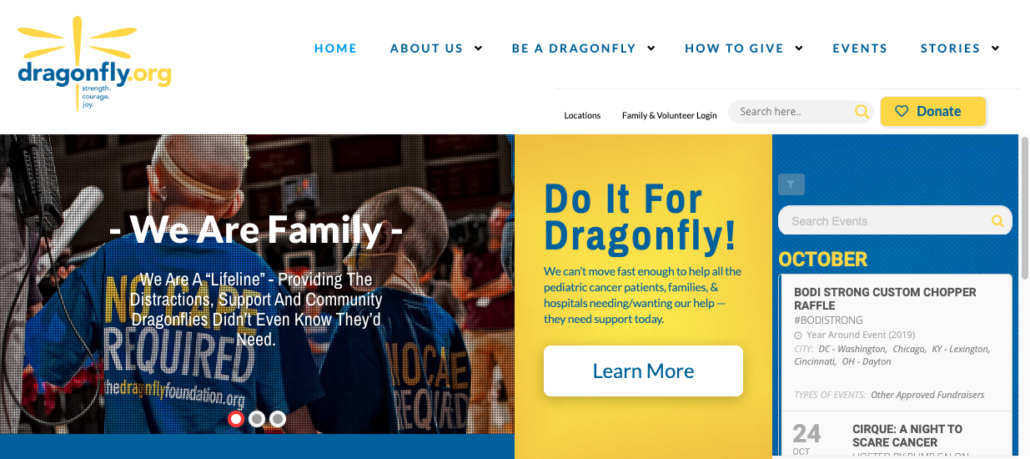
Navigation is another vital component to your website.
When a donor or sponsor is looking at your site and trying to figure out your values and fundraising efforts, they shouldn’t have to try hard to figure out where to go.
Navigating a site needs to be so easy a toddler could do it.
Take the nonprofit website above, for example.
At the top of their home page, they have a clear navigation panel that offers drop down menus that outline all the different aspects of their organization.
It is easy to find any information you could possibly be searching for.
If you do choose to hire a professional website design company, make sure to mention that navigation is very important to you.
If you’re redesigning your site yourself, make sure to pay extra close attention to this detail. Ask yourself if you can easily find information on your page. If you’re really concerned, get a volunteer or a friend to make sense of the site’s navigation.
Optimize Your Website For Mobile Devices
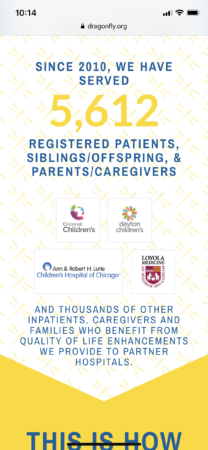
This can easily be forgotten.
When we think about websites and website design, we don’t typically think about how it will translate to a mobile device. This is where many nonprofits will go wrong.
How your website looks on mobile devices is definitely something you want to look into when you’re creating your site.
With 28% of mobile searches resulting in a call or visit, there’s a big opportunity to increase the awareness of your nonprofit and gain the attention of sponsors and donors.
This is bad news, however, if you aren’t monitoring how your website translates to mobile devices.
How your website converts to mobile devices will affect your ranking on Google. Google penalizes websites that don’t convert well to mobile.
This is something that is easy to fix.
When you are looking at your website design, make sure that you have a mobile-friendly option. If you have someone that is creating your site, stress that it needs to convert well to mobile devices.
There are a few characteristics that define an acceptable mobile-friendly site:
- It doesn’t require you to scroll side to side to read everything on a page
- It doesn’t require you to zoom to click on links
Basically, it’s the same website that you see on a computer, just on a phone.
5. Gain Popularity Online
Easier said than done, right?
Don’t worry, we have a few tricks up our sleeve to help you gain attention for your nonprofit online.
A great place to start is pushing your website to gain popularity.
This can be including it all your social media profiles, on informational brochures you pass out, and running digital ads.
Advertise your website as much as you can since it’s the single greatest place to learn all things your organization.
When you’re advertising your website, it’s also a good idea to establish who you are as a nonprofit. What are your values? What are you trying to accomplish? Why should we trust you?
Adding that extra information can make a difference when it comes to people deciding whether or not to look further into your cause.
Build High Quality Links
Getting backlinks is the number one way to improve your Google rankings. As a Cincinnati SEO company, we always focus on this with our customers.
There are two types of backlinks: internal and external.
External links are when another website links to one of your pages.
These types of links are what Google mainly considers when deciding where your ranking will be.
Having other nonprofits, governments, or universities link to your site establishes you as a credible organization.
It also helps raise awareness to your organization because someone else is mentioning you on their own page.
One way to generate external links is by giving value to others.
Say, for example, that you quote a famous activist that has done a lot for the cause your nonprofit stands for. If you quote them and link to their site, you can reach out to them and tell them that you referenced them in your post and are hoping they would read it. Hopefully from there that person will share the post on their own platforms. You never know where it can go from there.
Internal links are when you link from one page of your site to another. Typically, this will happen in your blog posts.
When you reference another post of yours, it’s better to link to it so the visitor can learn more.
These inbound links are extremely important too, and help visitors go to different pockets of your website that they’d never find without the assist.
(Need help ranking higher on Google? Try our link building services.)
Encourage Social Shares
When people share your content on their social media sites, it does boost your SEO according to Google.
Take the Dragonfly Foundation website.

They have options for their readers to share their posts on a variety of social media platforms. They also encourage readers to follow these pages as well.
By having readers share your content on their own sites, they are expanding your audience to people that are likely in some way similar to the reader. This increases the chances that they support your cause and want to learn more.
At the end of the day, the more people that see your content, the better. No one has ever said, “Too many people know about my nonprofit. I wish we’d be irrelevant!”
SEO compliments social media so this should really be something you spend time doing and utilizing.
Partner With Local Businesses
If you are a local nonprofit, you should 100% consider partnering with local businesses.
Even if you’re not a local nonprofit, chances are you operate at a local level and have different branches in different towns.
Reach out to popular local businesses to partner with you for some type of fundraising effort.
This can be as small as asking if they will donate a dollar of each of their online purchases to your cause. Or host an actual event where they contribute what they sell for the benefit of your organization.
Lots of people shop at these places and will at some point interact with your organization.
It could either be in a simple transaction where you’re just putting your name in the back of their mind or a breakthrough where a person realizes that they want to make a five-figure contribution.
Whatever it may be, asking local businesses for partnerships will help you gain popularity and start to have people recognize your name.
From an SEO perspective, you can use your local standing to your advantage.
You can create a roundup blog post where you interview a variety of local businesses asking them why they believe your city or town is important to sustain.
With this article, you are establishing yourself as a member of your community and you’re able to gain traffic from all of the shares the people you interviewed are likely to do.
It also is a great way to integrate yourself in your community. Becoming friends with local business helps you understand the community and the people that live in it to a higher degree.
Every great marketing campaign starts with understanding an audience.
Attempt Viral Marketing
Viral marketing helps grow the exposure of your content at an exponential rate.
Being a nonprofit, you have a slight advantage for natural feel-good moments.
Typically, content that gets shared a lot are stories that are positive and make you feel good.
People also respond well to content that makes them feel like they’ve made a positive contribution to the world.
As a nonprofit, you have the power to cater to both of those needs.
When you’re creating blog posts and SEO campaigns, you need to keep in mind what people actually want to read.
If the goal of your SEO campaigns is to go viral, then you need to do some research about what posts in your industry go viral and how you can use your own nonprofit to mimic these types of posts.
Once you know what people like to read, you should write your posts and then publish them as normal.
From there, your readers will share it with their friends, who share it with their friends, and the chain continues until the post is viral.
This doesn’t have to be your main focus, but it is an advanced tactic to try when you feel like you have the basics of SEO down.
In terms of SEO, we love to find methods that are not only effective, but also build upon each other.
Conclusion
There you have the entire recipe on SEO for nonprofits. Next up is for you to take action to execute each and every one of these strategies.
With the right patience and perseverance, your nonprofit can go from unheard of… to the talk of the town, state, and, eventually, nation.
And with that exposure, you can change the world!
Want more? Here’s a guide on measuring SEO ROI.


